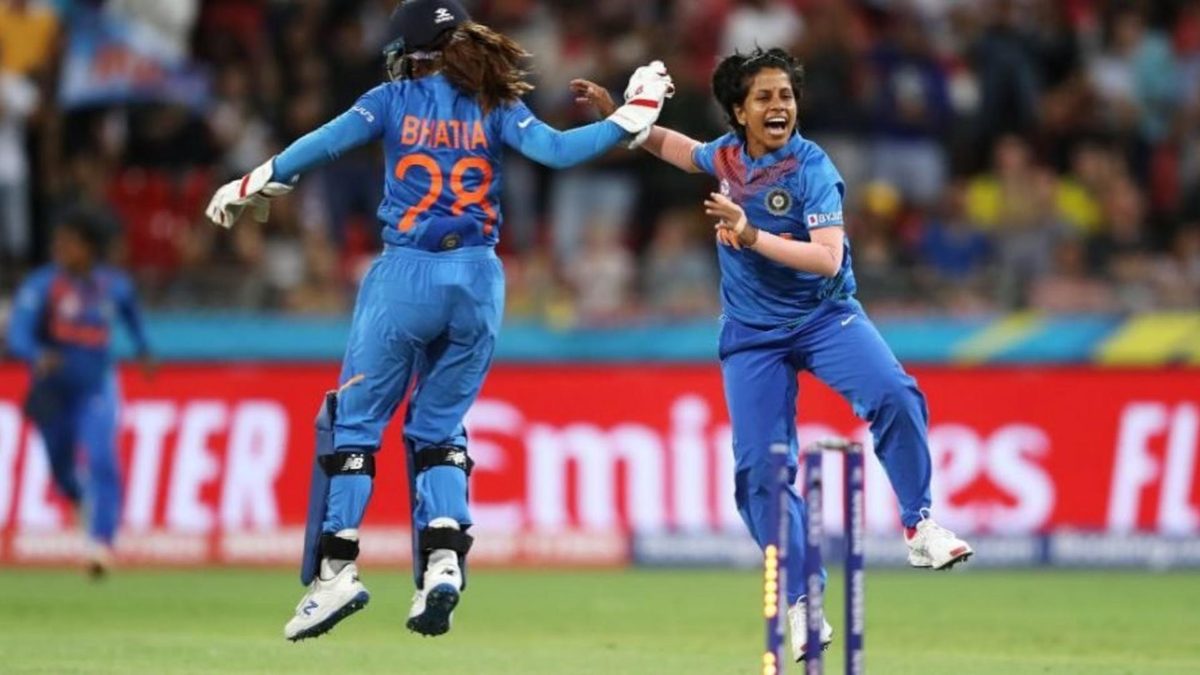
For India, this wicket of Australia’s dangerous opener was the turning point in an eventual win against the hosts in Sydney on the opening day of the Women’s T20 World Cup 2020. For Poonam Yadav, their senior leg-spinner, it was the first of four game-changing wickets on the day.
Since her debut, no woman has taken as many T20I wickets as India’s Poonam Yadav. Karunya Keshav speaks to the ace leg-spinner about her craft.
Alyssa Healy c & b Poonam Yadav 51 (35b)
But also, for Poonam, described by Ian Bishop during the tournament as the best leg-spinner in the women’s game, it was so much more. It marked an emotional triumph in a personal battle with herself as she claimed her place among the best.
When the leader of India’s attack came on in the 10th over of the game, fear hadn’t left her. About three weeks before, she had been in tears. An injury during a training session at the National Cricket Academy in late December had crushed her left index finger and pain was a constant reminder. Sitting out of the side on the sidelines of the tri-series in early February, she was “very afraid”. “Even a Cosco [soft] ball was hurting me,” she tells Wisden India.
The pressure she put on herself was immense. In the previous few months, Poonam was elevated to be one of only three players in the top rung of BCCI contracts. She’d won the annual BCCI award for best international player. She’d become India’s all-time leading wicket-taker in T20Is. She’d stood in front of the President of India, becoming only the 11th female cricketer to be presented the prestigious Arjuna Award that honours India’s top sportspersons. “After the injury, I thought, I’ve won so many awards. If, after all that, I don’t play the World Cup, how will it look?”
Poonam knew if she put in the work, she could bowl — the injury wasn’t on her bowling arm, after all. And since the time she switched from pace bowling to leg-spin as a young girl, she’s never shirked from hard work. “But my concern was, if I get a caught-and-bowled, can I manage? How can I even field?
“In tears, I told Tracy di [Fernandes, the physiotherapist], this is not happening, I can’t do this, I can’t catch. But she helped me lots. She said, ‘No, imagine that you’re playing the World Cup, you’re lifting the cup.’”
So Poonam did. And put in the extra work.
The eve of the opening match, she went through her regular routine, just more nervous than ever. She pored over videos of her opponents. She called her mum. She went through her visualisations. Her run-up. First step here, next step there. Areas to target ….
All through, she carried the weight of responsibility, of gratitude – of herself. The fielding coach had spent so much time with her. The selectors had retained faith in her, urging that she remain with the squad for the tri-series even if she wasn’t fit. The coach and captain had her back. “There are so many people who supported me. I had to prove them right.”
Ha ha ha. Don't be envious @alanwilkins22 😁😁. Shes my favorite legspinner in the modern game. pic.twitter.com/3xXhwl0nIh
— Ian Raphael Bishop (@irbishi) February 21, 2020
Running in to bowl that 10th over, she was reassured by her rhythm. She held her nerve when Healy saw a full toss off for six.
Fifth ball. Run-up. Rhythm. Slow, 62kph, flighted. Right areas. Edged, lobbed back … it sticks in her hand!
The c&b was just the morale boost she needed. “For a player, if she manages to pull off something she fears, for the sake of the team, it is good for confidence,” Poonam says. “After that, I felt, yes, I can win this match for the team.”
Poonam finished with 10 wickets in the tournament, inching ever closer to becoming the quickest to 100 T20I wickets.
***
In India’s World Cup match against New Zealand, Amelia Kerr, another star leg-spinner of this generation, took Poonam on, smashing her for 18 runs in the 19th over. Until then, the Indian had gone for just 14 from her three overs. Making full use of the crease, Kerr went back to her right to the balls wide of off and smashed them to the leg side.
It seemed someone had finally found a way to play Poonam.
The bowler though, disagrees. “She played two good shots, but two other balls, I bowled them in the wrong spot. I bowled too short,” she says, brushing off a “poor” over. “Those were boundary balls. But that’s not the way to play me. In the final, [Rachael] Haynes also tried to go back and play me the same way. And she got bowled.”
In her reading of the game, Poonam gives another whiff of just how good she is at what she does, but without enough credit – she still doesn’t feature in foreign T20 leagues. In the time since her T20I debut back in April 2013, no female bowler has matched Poonam’s 95 wickets. (Megan Schutt has 86 in three fewer games, while Shabmin Ismail has 80 in the same period.) Her average is the best among front-line bowlers of the top eight sides. This, even as she’s improved to be among the best in the world.
The Poonam of 2013, when she made her India debut, was timid, unsure of bowling long spells and intrepid with her variations. Why, even until 2017, she first used her googly on the international stage more out of desperation: In the World Cup, against an in-form Chamari Atapattu, she’d been smashed for four in her previous over. So, with a prayer and a leap of faith, she bowled her googly for the first time that World Cup, and as it happened, got a wicket.
It’s a far cry from the Poonam of today, who nearly got a hat-trick bowling just googlys in the match against Australia, and serves up a buffet of variations, including a newly developed flipper.
“A few years ago, I used to be afraid,” she admits. “So I couldn’t bowl with freedom, with heart. Now, there’s no fear, but there’s pressure and responsibility, that I have to win matches for my team, and keep improving.”
This maturity is built on the pillars of a sharp cricketing brain and a disciplined work ethic.
When England’s batting coach got on his knees to replicate the bowling arc of the diminutive Poonam for his batters, she responded with some tricks of her own. To deal with batters stepping out to her, she estimated their height and practised her lengths with cones placed accordingly. The theory is that her small hands makes her variations tough to spot – she counters that it makes it harder for her to bowl too – but she’s worked to keep her grip and release point as constant as possible, not making it any easier for batters to pick her.
According to her, the fundamental elements of her bowling are rhythm and ‘tappa’ — or where the ball bounces. For instance, when she bowled that googly to Atapattu in 2017, she was pleased with how much it spun, but she admits she had no idea what the ‘tappa’ should be. For months after that, for three days a week she practised just the googly — even though her shoulder constantly hurt from the effort — followed by three days of leg-spin, to bring her whole body in perfect alignment. Even today, she pores over videos, her own and others’, to identify where exactly the ball, having completed its slow floaty journey above the batter’s eyeline, drops to befuddle them.
Since about five or so years ago, when she felt she was struggling with her bowling, she’s been careful to stick to the basics, abandoning suggestions to tinker with her grip or release point. She only changed her run-up – which she finds important to setting her rhythm – and speed of bowling.
Poonam isn’t the slowest bowler in women’s cricket, but she’s on the lower end. Her style frustrates critics, quick to see hers as wickets gifted by impatient batters and off full tosses, rather than ones she’s earned. This does her a disservice.
“If I bowl quicker, it’ll come onto the bat better,” she says. “Instead, I need to make it difficult. People say it’s difficult to bowl slow. With slow balls, where you land the ball is important.
“You can’t have a long career with just one kind of delivery,” she points out. “Everybody knew how to play me. So every time I come home, I try to develop some changes to my bowling.”
***
Back at home in Agra, during this coronavirus-enforced lockdown, Poonam has plenty of time to “improve”. She’s pestered her father to build her some equipment to help in her strength training. He fashioned a rod of sorts, and they found some bricks, which they tied together to be weights.
Local jugaad by my father! But exercise is compulsory ?? ?️♀️ pic.twitter.com/EB61qMWiRz
— Poonam Yadav (@poonam_yadav24) April 6, 2020
While her diet has been thrown out of gear – she can no longer avoid wheat, as had been advised to her – she hopes the running and strength training she’s doing will keep her going for when cricket resumes.
“I want a World Cup,” she says. “I’m tired of seeing just silver medals! As a team, we’ve been performing well in the last few years. We just need to win a World Cup.”
Although a complete team person, you won’t see Poonam in the TikTok videos of her teammates, dancing in sync to Bollywood tunes. Not because she doesn’t let her hair down, she does, but because, “Dance in your own style, never anyone else’s!”
She’s talking about the dressing room, but she could well be sharing her mantra for all cricket itself.








